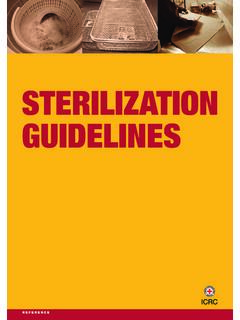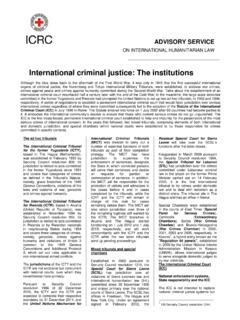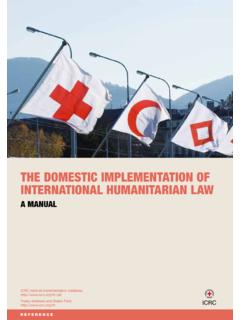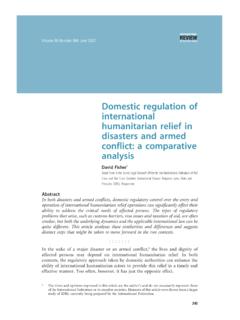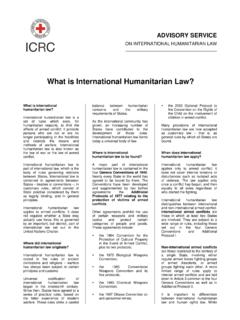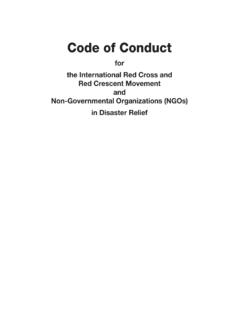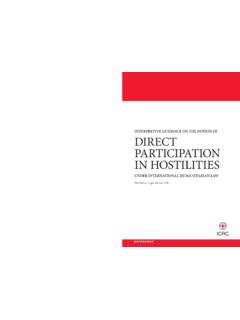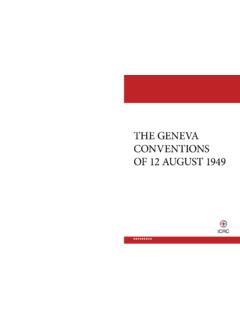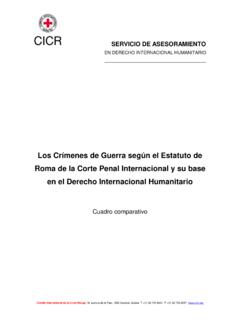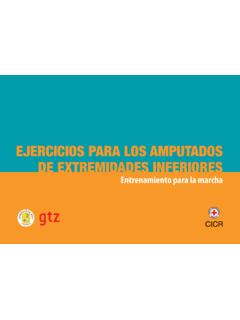Transcription of The worst scars are in the mind: psychological torture
1 The worst scars are inthe mind: psychological tortureHerna n Reyes*Dr Herna n Reyes, MD, of the ICRC s Assistance Division, is a specialist on medicalaspects of detention and has visited numerous detention centres around the during interrogation often includes methods that do not physically assault thebody or cause actual physical pain and yet entail severe psychological pain andsuffering and profoundly disrupt the senses and personality. Solitary confinement andprolonged sleep deprivation are just two examples of these psychological torturemethods. Even psychological methods which do not amount to ill-treatment whenconsidered in isolation, amount to inhuman or degrading treatment or torture , whenapplied in conjunction with other techniques, cumulatively and/or over a long they are part and parcel of the whole torture process and constitute a background environment of harassment and duress.
2 The cumulation over time factor must thus be considered as part of a system of psychological often sadly take pride in the fact that they do not resort to crudephysical methods in their work, but rely only on psychological methods ,1which they do not consider as torture . This calls for a discussion on what exactly ismeant by the term psychological torture . The following pages will examine whatconstitutes torture per se and, in particular, whether psychological methods usedduring interrogation can produce effects, mental or physical, that amount to may occur during detention, with the aim of punishing ordegrading and humiliating a article will, however, focus only ontorture applied during interrogations with the aim of extracting information.
3 *The author would like to thank Jonathan Beynon, MD, Co-ordinator for Health in Detention of theICRC s Health Unit, for his valuable comments on the various drafts of this article. The article reflectsthe views of the author alone and not necessarily those of the 89 Number 867 September 2007591 During interrogations, psychological methods are used specifically with the aim of softening up and thus breaking detainees resistance so as to make them talk .Their use often results from a state policy authorizing them either directly orindirectly, in the latter case by condoning the outset, it should be stressed that interrogations as such, so longas the methods used respect the rule of law, are legitimate. These methods havebeen described elsewhere,3and include different forms of interrogation techniquesand the use of psychological ploys.
4 The challenge is thus to determine whichmethods are legitimate and which are illegal, causing pain and suffering that fallinto the category of cruel and inhuman or degrading treatment or torture . Someof the methods used are physical methods, acting on the body and generallyproducing pain; others are psychological , that is, non-physical, and act on the methods are recognized forms of torture ; others which also may produce painand suffering, but to a lesser degree may not qualify as torture according to thedefinition. Yet other non-physical methods may appear to be minor or eveninnocuous when taken separately one by one. This paper will attempt to explore theuse of non-physical methods, and will consider whether and when their use canamount to torture according to the established definition.
5 It will in particular lookinto whether the use of such minor and apparently innocuous methods, whenapplied repeatedly, either singly or in combination and over a period of time, can alsoamount to cruel, inhuman and degrading treatment, or even the legal definition of tortureDefining exactly what torture means seems to be as complex as defining whatshocks the conscience in the case of pornography. A US Supreme Court Justiceonce said with regard to the definition of pornography,I shall not today attempt further to define the kinds of material I understandto be embraced [by the term pornography] .. but I know it when I see it!4 There is nevertheless a universally accepted definition of torture today,namely the one contained in the 1984 UN Convention against torture (CAT),2In the case of Raquel Marti de Mejia (Raquel Martin de Mej , Caso Informe No.)
6 5/96, , Doc. 7 at 168, 1996), the Inter-American Court of Human Rightsstressed that the purpose element can include punishment or humiliating and intimidating theperson. It is not restricted to extracting information from a psychological methods of interrogation go beyond the scope of this paper, but the mostwell-known ones can be listed here: fear up ; pride and ego ; futility ; we know all ; good cop/bad cop ; silent questioning and others. SeeField Manual(FM) 34 52, Intelligence Interrogation, USDepartment of the Army, Washington DC, 28 September, 1992, Chapter 3, Approach phase andquestioning phase , 3 10 and 3 20. Available at (last visited9 October 2007). See also Rau l Toma s Escobar,El interrogatorio en la investigacio n criminal, EditorialUniversidad, Buenos Aires, 1989, pp.
7 312 acknowledgment was made to the author on several occasions by detaining authorities, in differentcontexts, during ICRC visits to prisoners during the last two Potter Stewart trying to explain hard-core pornography, or what is , 378US, 184 (1964), Appeal from the Supreme Court of Ohio (in footnote 11), available at (last visited 8 October 2007).H. Reyes The worst scars are in the mind: psychological torture592which defines as torture any act that consists of the intentional infliction of severepain or suffering, whether physical or mental , involving a public official andcarried out for a specific Inter-American Convention to Prevent andPunish torture has a broader definition of torture ,6which does not have toinclude the infliction of severe pain and suffering.
8 In international humanitarianlaw (IHL), torture does not have to be inflicted by or with the acquiescence of apublic official, but can be perpetrated by any these various interpretations, when it comes to defining torture the main elements remain those laid down in the CAT. An importantcharacteristic of this Convention is that it introduces a significant differencebetween the term torture and other acts of cruel, inhuman or degradingtreatment or punishment (CIDT): it bans torture completely and absolutely ( ),7while imposing on states only the obligation to undertake to prevent cruel, inhuman or degrading treatment (Art. 16). States have used this to arguethat while torture is forbidden, cruel, inhuman or degrading treatment may bejustified under exceptional circumstances.
9 If such treatment is to be allowed incertain circumstances, but not torture , the differentiation between these twonotions becomes legal instruments, however, do not differentiate between the twoterms. The International Covenant on Civil and Political Rights (ICCPR), forexample, prohibits in absolute terms both torture and inhuman or same is true of the European Convention on Human Rights(ECHR).9 International humanitarian law equally forbids torture (whetherphysical or mental) and cruel, humiliating or degrading treatment, as well asany form of physical or moral the practical application of the provisions, the European Court ofHuman Rights has distinguished between torture and cruel, inhuman or5 Article 1 of the CAT defines torture thus: 1.
10 For the purposes of this Convention, the term torture means any act by which severe pain or suffering, whether physical or mental, is intentionally inflicted ona person for such purposes as obtaining from him or a third person information or a confession,punishing him for an act he or a third person has committed or is suspected of having committed, orintimidating or coercing him or a third person, or for any reason based on discrimination of any kind,when such pain or suffering is inflicted by or at the instigation of or with the consent or acquiescence ofa public official or other person acting in an official capacity. It does not include pain or sufferingarising only from, inherent in or incidental to lawful sanctions. 6 The Inter-American Convention to Prevent and Punish torture defines torture in Article 2 as any actintentionally performed whereby physical or mental pain or suffering is inflicted on a person forpurposes of criminal investigation, as a means of intimidation, as personal punishment, as a preventivemeasure, as a penalty, or for any other purpose.
